Wikipedia tells us that the surface area of Prince Edward Island is 5,660 km2.
The square root of 5,660 is 75.23, meaning that, if reconfigured to be a square, PEI would be 75.23 km by 75.23 km.
NASA tells us that “freshly-fallen snow has a density of 50 kg/m3.”
One centimeter of freshly-fallen snow on a 75.23 km by 75.23 km box is a cube that’s 7,523,000 cm by 7,523,000 cm by 1 cm.
That’s a cube that’s 56,595,529,000,000 cm3 or 56,595,529 m3.
At 50 kg/m3 that means that a one centimeter snowfall on Prince Edward Island has a mass of 2,829,776,450 kg, which is 2,829,776.45 metric tons.
So an 86 cm fall of snow has a mass of 226,382,116 metric tons.
Dump trucks vary, but it seems their capacity is around 32 metric tons, so that’s about 7 million dump trucks worth of snow.
Is my math correct?
Posting this here just in case others find themselves in the same situation.
Since migrating this site from my own silverorange-colocated server to Amazon AWS, I’ve been experiencing seemingly random Apache server outages. The usual suspects – mismatched Apache and MySQL settings, lack of memory, etc. – didn’t seem to apply, and the symptoms were confoundingly simple: all of Apache’s processes – up to the MaxClients settings limit – would be “hung,” and the server would be unreachable. But MySQL was fine, the system load was fine, and, as near as I could tell, everything was beautiful and sunny. Except that Apache was, effectively, hung.
After several weeks of Googling away for “Apache hung processes” and “Apache process limit” and “Apache crashed” and “mysterious and confounding Apache issue,” I launched into some more serious Apache debugging and eventually traced the issue to some variation of APC and this PHP issue. The debugging that got me there was running strace on any of the child Apache processes and seeing:
futex(0x2b19a0b01070, FUTEX_WAIT, 2, NULL)
Rather than trying to solve the APC issue itself, I solved the issue – fingers cross – by upgrading from Apache 2.2 to Apache 2.4 and from PHP 5.3.29 to PHP 5.5.20. Among other things, this let me jettison APC and use PHP OPcache instead. Which appears to have addressed the larger issue, and given me access to a nice OPcache visualization to boot:
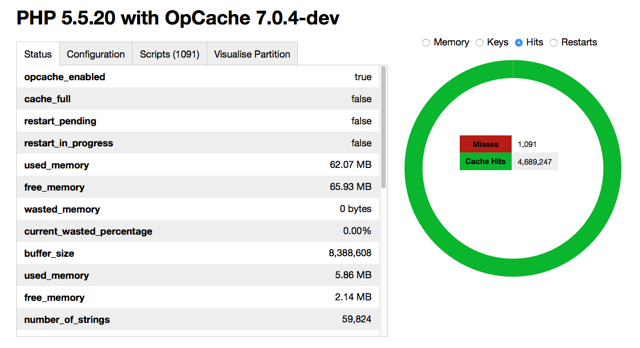
It snowed. For two days. 86 cm worth of snow in Charlottetown at last report.
And then it was over. Today is a bright, sunny day. Schools are closed. Businesses are closed. There is a lot of snow. Everywhere.
However, by some miracle, the sidewalk plow passed in front of our house early this morning.
And our resourceful neighbour flagged down a snow-thrower-equipped tractor yesterday and paid him to blow out our driveway.
And the walk from home to office, although without sidewalks, is passable. And Receiver Coffee is open. And the side door of the Reinventorium was free of snow.
It’s almost as if the storm never happened.
I may be unique in this viewpoint.
So yesterday I gave my Jetta the day off, in the humid and warm confines of the Delta Prince Edward underground parking lot.
Around supper time I retrieved the car and returning it to the frigid temperatures of the Charlottetown night. I drove home, parked for a few minutes, then drove across the Hillsborough River to Stratford for a couple of hours, then headed back home.
I noticed, while heading across the bridge the first time, an unusual high-pitched whine from the engine, and also noticed that my headlights didn’t appear as bright as they usually do. On the way back home I pulled into the Riverside Irving to clear my windows and when I tried to start the car back up it refused to start, showing classic signs of a dead battery.
I rang up brother [[Johnny]] and he heroically hopped in his car and came to my rescue; by the time he arrived I’d managed to start the Jetta back up, but it continued to act strangely.
And so I decided the best course of action was to hobble over to Dave’s Service Centre – you remember Dave’s, right? – and found, to my surprise and delight, that Dave himself was still in the shop. We had a chat and he deduced that it was likely an alternator failure at the root of the issue: the car had been running on battery alone, which was why it refused to start and why the lights were dim.
So I left the car with Dave, and am waiting to hear back this morning.
Moral of the story? Never give your car the day off.
After a slow start, the snow has come to Charlottetown in droves over the past several weeks. By some miracle, we’ve managed to keep our car shoveled out and driveable, in no small part due to the generosity of mysterious forces that have conspired to blow out the space between the road and the sidewalk that gets packed tight with snow from the plows (whoever you are: thank you).
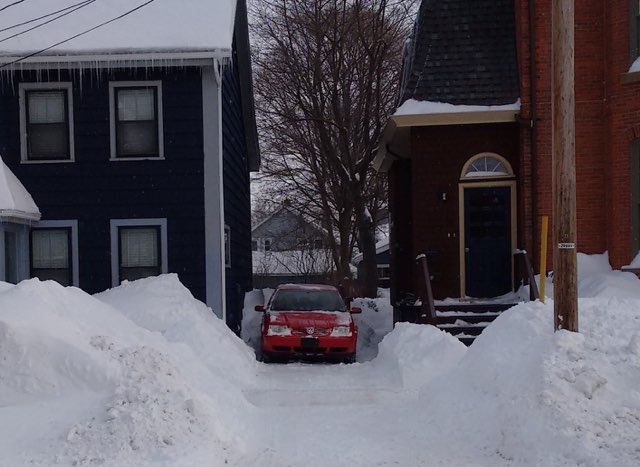
Our car – now 15 years old – still starts on all but the coldest of cold mornings. But in the last storm the wind snow and rain and temperature combined to deposit solid blocks of ice in the space in front of the front doors, meaning they don’t open completely and thus require the driver to execute a complex limbo-like manoeuvre to enter the car.
To solve this issue, at least for now, I’ve given the car a day off: after running Oliver to school and Catherine to an appointment, I drove down to the Delta Prince Edward and left the car in the underground heated garage for the day. The Jetta breathed a satisfying sigh of relief as soon as it was hit by the warm underground air: I’m looking forward to returning in 8 hours time to pick up a refreshed car with openable doors.
Podcasting, it seems, is undergoing a renaissance. And my favourite of the new crop is Invisibilia from NPR, a podcast (and, apparently, also a radio program) that “explores the intangible forces that shape human behavior.”
They are four episodes in now, and I’ve been fascinated by something – and usually more than one something – on every episode I’ve listened to.
Their description of the three schools of psychotherapy – who knew! – in The Secret History of Thoughts and the part of the Entanglement episode discussing how distant atoms can somehow at once be the same atom, are the highlights for me so far.
I encourage you to listen.
My podcast-listening application of choice (thank goodness “podcatcher” never took off as a noun) is Pocket Casts, which is available for both iOS and Android and here’s what you’ll find in my subscription list these days (the links are the podcast subscription links that you can add to your, er, podcatcher):
- Planet Money - also from NPR, I enjoy their approach to money and the economy; it’s a sweet spot between lowbrow and highbrow.
- 99% Invisible - design, architecture, curiousities.
- Transom - seldom updated, but the back catalogue of independent documentaries is rock-solid.
- Invisibilia - as above!
- CANADALAND - hyperbolic, but interesting nonetheless.
- Slate’s Working - where did it go? I hope it returns, as each episode’s focus on the quotidian aspects of a different profession was gripping.
- Reply All - technology with a humanist bent.
- Radiolab - arguable the grandfather of Invisibilia, and a pioneering user of what might be called “cinematic” techniques in radio.
- Longform - a collection of interviews with writers about the craft (sort of like “Working,” but broader in scope but limited to a single profession).
- Mark Kermode and Simon Mayo’s Film Reviews - I can’t imagine going anywhere else for film reviews; my longest-standing subscription.
- StartUp - a podcast about starting a podcasting company; I love it.
- TravelCommons - much less regular in recent years, but I keep listening because of the focus on the quotidian aspects of business travel.
- This American Life - the classic.
It appears, as I write those thumbnails, that “quotidian” is my passion of choice.
Here’s an OPML file of all of the above that you can import into your podcast-listener if you want to slurp them all into your life too.
I have found myself in possession of a letterpress cut of former Prince Edward Island Premier Alex B. Campbell’s signature.
While I thought briefly that I might use this great power dash off some quick orders in council for planting in the provincial archives, I thought better of this, and decided instead to set a passage from one of his speeches, one quoted in Alex B. Campbell: The Premier that Rocked the Cradle that was delivered at the Canadian National Exhibition in 1967.

I’m debating justifying the text; I’m generally more of a ragged-right person, but perhaps it would suit in this instance.
A few weeks ago I noticed an advert on A Softer World that looked like this:

If there was ever an ad crafted to attract my attention, it was that: the “interesting” caught my eye, the “$1/Day” pulled me in, the tiny graphics sealed the deal.
So I clicked, and ended up at the Box Bot which describes itself like this:
Bobcat In A Box is an automated program (or a “bot”) that sends you lots of little packages, bought from eBay and other sites across the internet with free shipping. It buys you at least one package every day. You can give the bot instructions as to what sort of packages you want, for example to only buy beads or postcards or anime items, or you can have it buy completely random packages and let the bot surprise you!
Right. Up. My. Alley.
How could I not sign up?
So I did. In [[Catherine]]’s name, as she’s a art practice that can profit from a random scatterling of interesting ephemera. I specified the keywords “fabric, wool, knitting, fibre, postcards, flags.”
And, yesterday, the first package arrived. From China. Four pieces of fabric, nicely swaddled in cellophane wrap.
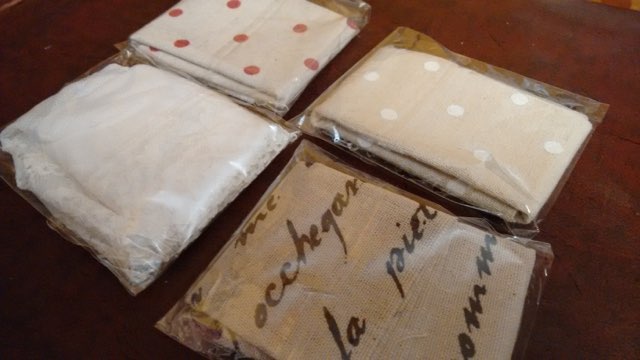
“How is this possible?” is the first question that comes to mind: it’s hard to conceive of what economic model allows the cost of the product, the labour to assemble and ship it, and the shipping costs to come to less than $1 and still leave room for profit. The Box Bot FAQ addresses this unsatisfyingly:
How do the merchants make money on $1 items with free shipping?
The short answer is that I don’t know. For many of the items, merchants are certainly selling at a loss. But there are lots of sellers, on eBay and other online platforms, who keep offering items for next to nothing with free shipping….so the bot will keep buying them! As most of the items are shipped from Asia, many of the merchants pay several dollars for “free shipping”. A good number of the items bought by the bot will have “Shipping: $5” or something similar printed on the custom form! Even though the cost to ship is several times the winning bid, merchants fulfill the order and ship the items the bot buys. Perhaps they have a discounted shipping deal that makes it worthwhile. It is something of a mystery as to why they offer the items for such low prices on eBay, as it is easy to set a reserve price or start the auction at a higher bid. Perhaps the merchants ship these small items to boost their feedback scores or hope that they will be bundled with other purchases.
So the “how” remains a mystery. But it works. And I can’t wait to see what comes next
Longtime readers will recall that 4 years ago I related the story of how L.L. Bean exchanged my 5 year old winter jacket with a broken zipper for a brand new winter jacket (and an $86 windfall).
That replacement jacket served me well: it had an almost-idea combination of multiple pockets, warmth and longevity that I hoped it would be my winter jacket forever.
That was until it started to experience zipper problems of its own last month: gradually worsening over time, the zipper stopped zipping up effectively, so that I’d find myself walking in -30ºC weather and my zipper would suddenly zip open. By last week I was batting 25% on a successful zip-up, spending 3 or 4 minutes every time I wanted to go outside trying to find the magic trick that would make the zipper stick.
As it happened, I was in New England last week again, driving right by the selfsame L.L. Bean Wayside Commons. In anticipation I returned again to the 100% Guarantee page on the L.L. Bean website and found the committment stands:
Our products are guaranteed to give 100% satisfaction in every way. Return anything purchased from us at any time if it proves otherwise. We do not want you to have anything from L.L.Bean that is not completely satisfactory.
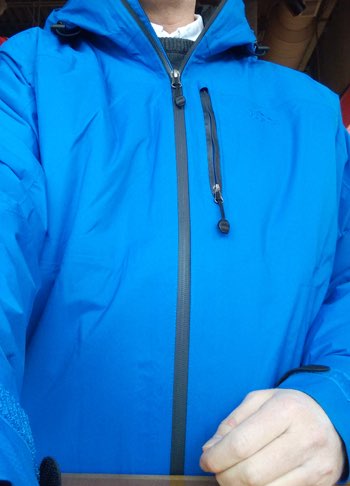 So on Friday afternoon, en route from Yankee Publishing to Boston Logan Airport, I took exit 33A from Rte. 128 north and found myself, 4 years later, again looking to exchange my L.L. Bean winter jacket.
So on Friday afternoon, en route from Yankee Publishing to Boston Logan Airport, I took exit 33A from Rte. 128 north and found myself, 4 years later, again looking to exchange my L.L. Bean winter jacket.
Much has changed, it seems, in the world of winter jackets since 2011: puffy down-filled jackets are in, and ones like my trusty Bigelow are not. So it took a lot of sorting through the jacket stock to find something that would suit.
Ironically, I ended up with the same coat, the Weather Challenger, that I started with almost a decade ago. It retails for $199 these days, and my Bigelow originally retailed for $149, so I ended up with a new jacket for $50.
At no point in the exchange process was I made to feel as if I was doing anything unusual, leading me to be believe that not only does L.L. Bean stand behind its products, but that they communicate this to their employees to the extent that everyone internalizes it.
So a tip of the hat to L.L. Bean and the friendly staff at Wayside Commons: I’m warm and well-zippered yet again.
I’ve been archiving Prince Edward Island electricity load and generation data for more than 2 years now, but to date the only way of visualizing that data was a confusing graph. A graph that loads really slowly – or not at all – on mobile devices. And so I found my “peripheral aggregate electricity awareness” sinking.
So in an effort to scratch this itch, I coded up a small single-purpose mobile-friendly website yesterday, http://pei.consuming.ca/, that looks like this:
![]()
The website tells you three things: what the total electricity load on Prince Edward Island is right now (“how much electricity we’re all using”), how much of that load is being met by wind-energy generation, and what percentage of the load the wind represents.
In the screen shot above, taken this morning at 8:30 a.m., the load is high at 232 MW (peak load on PEI is 268 MW) and only a small fraction of that load, 11 MW or 5%, is being met by the wind (the remainder is coming from local fossil fuel generation and over the submarine cable from New Brunswick). Both the load and the wind were lower than the last report, which is why the light grey arrows are both point downward.
You should be able to load up http://pei.consuming.ca/ in any relatively modern mobile or desktop browser: the chart is drawn with jCanvas and the site uses the jQuery Mobile framework.
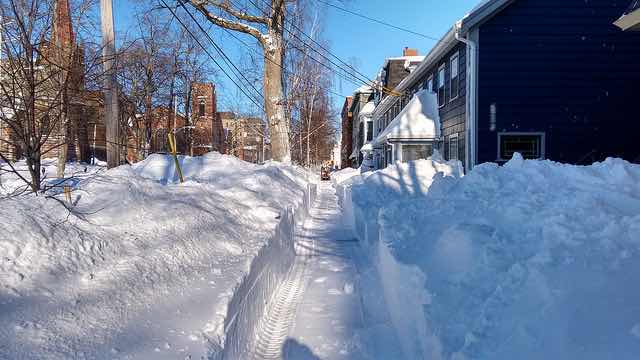
 I am
I am